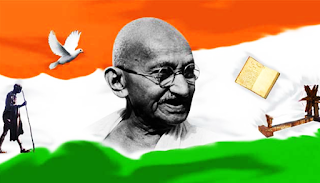Mahatma Gandhi as an Authentic Leader
My initial understanding of authentic leadership led me to thinking about Mahatma Gandhi. This was a man who had a set of beliefs that he lived by, and did his best to unite his nation under the values he had set for himself. I watched a great YouTube video (link provided below) that helps to explain Gandhi as an authentic Leader. He exemplifies George (2003)’s Authentic Leadership Approach. In this approach to leadership, there are five dimensions in which a leader can go from “having less of” to “having more of” in each dimension, and that a leader can work to improve each set of skills needed to thrive in each (PSU WC, Lesson 12). The five dimensions that George describes are purpose, values, relationships, self-discipline, and heart. It is easy to see how Mahatma Gandhi used these dimensions to shape his views on life and on how to lead his people.
Gandhi showed his authentic leadership through similar dimensions described in our lesson commentary. He used self awareness as a way to help his fellow countrymen follow their hearts, and to stand up for what they believed was right, even if it was a task that seemed to be unreachable. Gandhi believed that, “Everyone who wills can hear the inner voice. It is within everyone.” He truly believed that if you really wanted to accomplish something then it was within your power to get it done, no matter what the risks were. A well known example of this is Gandhi going on extremely long periods of fasting, where he would no eat for many days at a time. This was his effort to enact change in India.
Another sub dimensions of Gandhi was relational transparency. All followers of his were welcomed with open arms. Relational transparency is about being open and honest in front of others. Individuals are sharing their deepest feelings, goals, values, and inclinations with those around them. This includes both positive and negative aspects. Gandhi wanted his followers to be true not only themselves, but also to their peers. If this was achieved, they would all be able to strive for goals that they all believed in, and like Gandhi stated, anything is possible when one can hear the inner voice.
A final sub dimension of Gandhi’s authentic leadership was having a balanced processing of information. As most of the world knows, Gandhi believed in a taking a passive stand against violence. He used specific passive aggressive techniques to get what he wanted. Gandhi stated that, “First they ignore you, then they laugh at you, then they fight you, then you win.” This type of passive attitude showed his followers how dedicated he could be to a cause. Whether he was beaten to near death or did not eat for long periods of time, he was not going to quit when he was on a mission to succeed.







Comments
Post a Comment